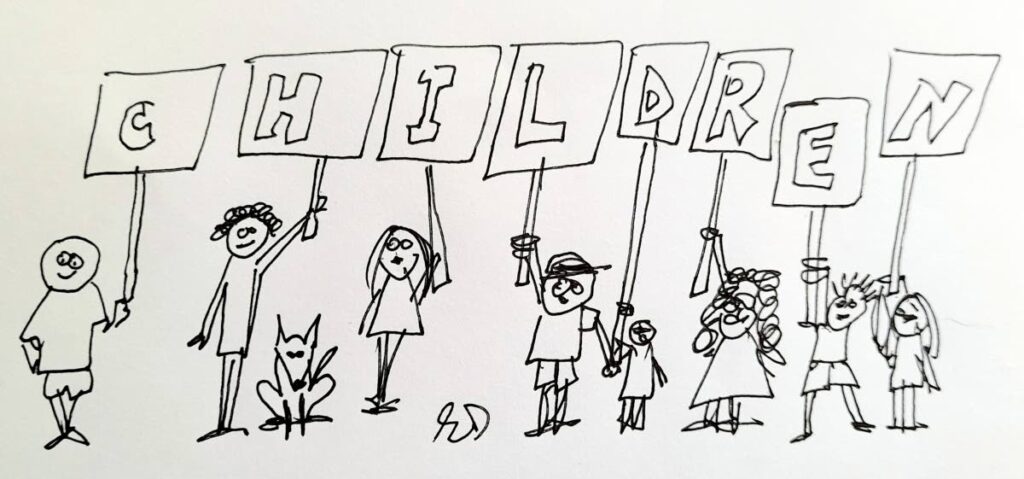C.H.I.L.D.R.E.N.

When I think about "children in the news," one of the first things to come to mind is the shocking number of reports of young girls and, sometimes, boys who are molested and sexually penetrated by grown men – relatives, friends or strangers – sometimes up to ten times their age or more. Whether it is that cases are increasing or more victims are speaking out (or both), the fact remains that this rampant problem cannot be overlooked. Parents and guardians are continually being called upon to be more vigilant and protective – but how many can or know how to be, considering that they themselves are not the perpetrators?
Children featured in the news also include those who have been found bruised, beaten, with multiple injuries inflicted through blunt force trauma, unresponsive, dead. Reasons for the sometimes fatal physical abuse may include anger, vengeance, discipline/punishment, frustration, and intoxication – to list a few possibilities. "Persons of interest" are usually "a male relative" or, less frequently, female. So-and-so has been "held".."‘is being questioned"..." remains in police custody"..." investigations are continuing."...Those phrases have become as expected and redundant as the weatherman/woman’s waves that have been "up to two metres in open waters and below one metre in sheltered areas" for what seems like an eternity.
Reports of children producing pornographic material in or out of school and sharing it via social media are disturbing to most, but perhaps no longer shocking on account of frequency. Add to that the recent report of alleged paedophiles applying for teaching positions so that they can have easier access to a wider range of potential victims. If sex education is introduced to the school curriculum, how might the presence of such predators impact adversely upon the intentions of the programme?
Lately, with disturbing regularity, news reports have mentioned children witnessing the suicides of their parents or the murder of one parent by another, followed by the suicide of the perpetrator. Those young people either view the deathly acts as they occur, or happen to stumble upon the body/bodies in the aftermath. Either way, the trauma resulting from such experiences is unimaginable, beyond the scope of the average person's comprehension.
I remember as a young child, being silently terrified, if not mildly traumatised, upon inadvertently overhearing (on two separate occasions) my parents and other adults discussing cases of murder and/or suicide. Those were specific examples of a domestic nature, where the victims and the perpetrator were known to us – everyday people living in the general neighbourhood. One case was the suicide of the mother of some children we knew; the other, the murder of a mother, the wife of a foreign lecturer, stabbed to death with a kitchen knife. In both cases, from what I recall, children were involved, either witnessing the act or finding the deceased thereafter. Decades later, I still remember the moment, place and general time of day at which I overheard those discussions and the associated images that had popped into my young mind. I give this example only to illustrate the kind of impact that such events can have on children. Try to imagine, therefore, the impact upon young ones who do not simply overhear, but personally experience such tragedy through the acts of their own parents.

No matter how much their parents may try to shield them, children all over TT must be experiencing some level of trauma simply on account of having to live in this society and being easily exposed to its dysfunctional and disturbing realities (generally adult-related) through the media, hearsay or, unfortunately in some cases, direct experience.
Even a potentially positive news report related to children can find itself tainted by the inefficiency of systems created and maintained by adults. What could have been a congratulatory report on the academic achievements and award received by a young student was transformed into a fiasco by a mix-up in the Secondary Entrance Assessment (SEA) top score award for 2020.
While there are some positive child-related reports in the local media, much of the news (some examples given above) that has grabbed the attention of the nation in recent times has not been encouraging.
May more children of this nation experience positive life influences and opportunities to find healing from the trauma that they inadvertently experience in the course of everyday life. May the acronym of who they are, be our focus:
Compassion
Healing
Inspiration
Love
Discipline
Respect
Education
Nurturing

Comments
"C.H.I.L.D.R.E.N."